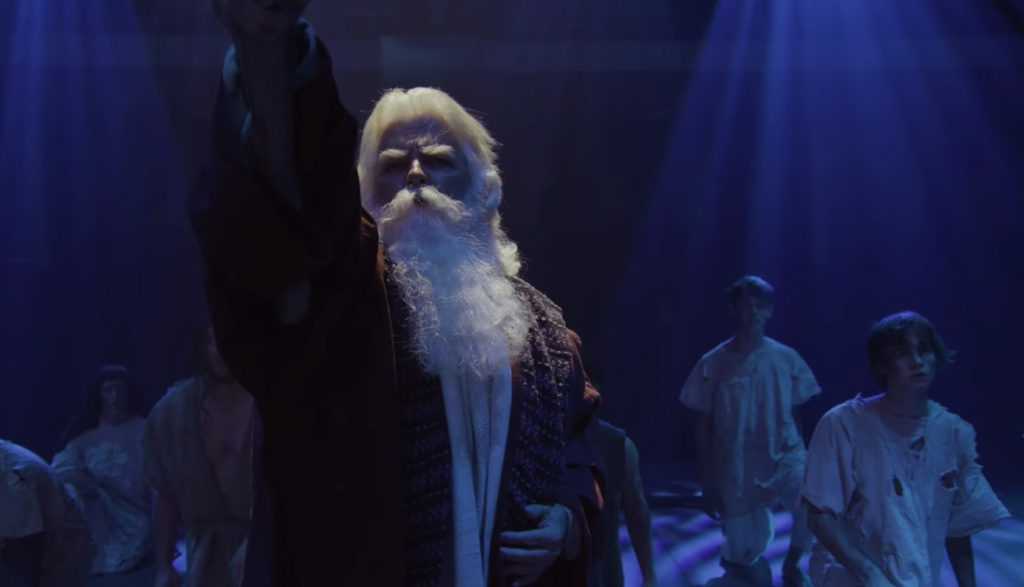
Not much changes in the Roman Empire. At least not from Asher’s point of view.
Granted, the kid doesn’t have many years under his belt. But ask his mother? Grandmother? Great grandmother? The chains are still as heavy, the work is still as onerous, the freedom—at least the legal kind—is still as elusive. Sure, emperors may come and go. Borders may shrink and grow. When you’re a slave on the island of Patmos, though, the view doesn’t change much.
But sometimes, even slaves—especially young slaves—get the urge to shake things up a bit.
Young Ashur steals a ring from his master and steals into the night. He has no clear idea of what to do now, or where to go: It’s hard to hide for long on an island just 13 miles square.
He tumbles into a cave and sees—a man. A very old man, and one who seems oddly welcoming.
“Come to steal my food, didn’t you?” the old man asks with a twinkle in his eye. But then he reassures the boy. “You’ve come to do your clever bit of thievery in a safe place.”
The man tells Ashur that he’s a prisoner, too, exiled for years on this tiny island. He was sent there because—
Well, that, I suppose, is related to the story that the old coot wants to tell.
They call faraway Rome the Eternal City. Millions live, work and die beneath its eternal shadow. For people like Asher, the landscape of generations looks the same. The chains never lose their weight.
But the man has a surprise in store for Ashur. Without warning—without most people even knowing—change came.
What changed?
Everything. And the man—John—wants to tell Ashur all about it.
The Thorn is, of course, an imaginative retelling of Jesus’ life, ministry, sacrifice and resurrection (along with some other biblical elements here and there), one that often involves dance and music. For Christians, that tale is indeed staggeringly positive.
But just for kicks, let’s step outside our own familiar faith environs and look at the story through Ashur’s eyes—through the eyes of someone who knew nothing of Jesus’ life or significance thereof until he set foot in John’s musty old cave.
John’s a kindly man, clearly. He’s not out to turn the young slave in for attempting to flee. He even shares with Asher his food (which can’t be that easy to come by) and the warmth and light inside. He’s taking a risk even talking with Ashur, given that the kid’s now a fugitive from justice. But John feels his message is an important one.
And then, through John’s story, we see Jesus at work—healing people, feeding people, literally giving some of them new life. He started teaching them about a whole new way of living, too. And while a lot of folks were hoping this guy was the Messiah—that is, the man who’d help the Jews sluff off the Roman yoke—the freedom He was ultimately promising was far different, more profound and, ultimately, a whole lot longer lasting.
The Thorn is, obviously and inherently, a religious story. Not one moment of it can be separated from its biblical sources.
It begins at, literally, the beginning: God’s creation of creation, Lucifer’s rebellion and fall, Adam and Eve failing temptation in the Garden of Eden. But most of the movie’s runtime is spent chronicling Jesus’ time on Earth, extending from the Annunciation to His Resurrection. We’re witness to dance-inflected pantomimes of many moments in Jesus’ ministry—calling His disciples, curing the blind, raising a girl from the dead. When he cures a lame man, the recipient of the miracle doesn’t just walk: He breakdances.
None of this plays out as a typical movie might portray it. Most of the actors are silent. The events are instead narrated by John, bringing biblical context and depth to the scenes we see. And sometimes he departs from Jesus’ chronology to speak directly to Ashur—and, by extension, the viewer.
“Satan is very real indeed,” John tells the slave boy. “He is the whisper in your own mind, the one who condemns you. Who says you are a thief. [That] you have the heart of a thief. Do not believe him. … You are not unlovable. You are not this worthless thing you believe you are.”
Speaking of Satan, he’s a big player in the events we see. He’s with Judas in the midst of his betrayal. He’s lurking at the crucifixion itself, reveling in his apparent victory. And in one of the movie’s most surreal, extrabiblical turns, he and his minions swarm the Garden of Gethsemane as Jesus desperately prays—his own prayer time defended by dancing angels.
The Thorn concludes with John telling Asher just how much Jesus changed everything: how the disciples spread the Gospel to all corners of the world; how both Jews and Gentiles found new life and hope; how at least one player in Jesus’ death was himself redeemed, driving home the message that no one is beyond Christ’s salvific reach. And it even offers us another Christlike sacrifice.
Certainly, The Thorn isn’t a word-for-word recitation of the Bible. It, like The Chosen, sometimes speculates (and with far more dance than we’ve seen thus far from Dallas Jenkins’ television series) on what certain biblical scenes might have looked like. But while it makes no claim of being a historically accurate documentation of Jesus’ ministry (and no one who watches would mistake it as such), the spirit and the purpose of the film is unmistakable.
As mentioned, The Thorn takes us into Eden. And while Adam and Eve are thoughtfully covered, audiences will see some skin. Adam is shirtless, for instance—and he’s hardly the only guy to go sans top. Sometimes, even when players are technically covered, The Thorn implies they are not: They wear skin-tight garb painted to augment their muscles.
Given all the dance elements in The Thorn, it’s no surprise that men and women alike wear form-hugging dancewear. Demonic temptresses writhe about Judas in a critical scene as well.
In its earliest days on stage, The Thorn earned some notoriety for its bloody scourging and crucifixion scene. In the movie, those elements are throttled back some. Some of that is inherent in the move from stage to screen. While the gore was hard to turn away from in The Thorn’s live performance, here the camera forces us to consider other elements within the scene: the grim determination of Jesus’ human tormentor; the whip rising and falling; the glee of Satan, circling the scene like a muscled serpent.
But be warned, there’s still plenty of blood onscreen, and The Thorn’s own website warns would-be attendees that it contains “graphic content.”
Jesus’ wounds look horrific. Red covers Jesus’ body and, later, stains his shroud. The scene of Jesus’ scourging lasts a long time, and purposefully so: John describes the whip in detail, and how it was “designed to tear a man apart.” He describes Jesus’ wounds too. And while the movie obviously doesn’t show nails driven into Jesus’ flesh during the actual crucifixion, we can see the horrific pain on his face.
Judas’ suicide is dealt with more obliquely, the stage going dark before the actual act is committed. A battle in the Garden of Gethsemane is more West Side Story than a scene from a war movie. We see gladiators in action as the film opens, and someone’s throat appears to be cut (but bloodlessly). A Roman soldier apparently stabs someone off camera. We hear about some of the torments that John himself suffered at the hands of his persecutors, including being boiled in oil. “Who does that, anyway?” he exasperatedly asks.
None.
None.
I guess you could argue that Ashur really shouldn’t have stolen that ring. But then, who would’ve John had to talk to?
In a way, The Thorn is a modern iteration of a centuries-old tradition: the Passion Play. A Passion was performed in Vienna by at least the 14th century. Tyrol ( a region in Austria) was producing a seven-day Passion play by 1514. The most famous Passion performance in Oberammergau, Bavaria, has been held once every decade or so since 1634.
These plays all take their name from the Latin verb Patior meaning “to suffer.” But in a way, they could be called paradox plays as well.
After all, Jesus was both fully God and fully man. His greatest victory looked like defeat. In death, He found life—and He made us realize that, while we lived, we were dead without Him.
And while that story has been told in countless ways over the last 2,000 or so years, we’ve often found room for a fresh take, a different perspective, a new imagining.
The Thorn tells this age-old story in new, often unexpected ways. It’s filled with rhythmic gymnasts and dancers and aerial acrobats—a stage extravaganza where Satan flexes menacingly and angels sometimes appear to do battle.
Obviously, for Christians who like their biblical stories to stick to every word and punctuation mark in Scripture—no more, no less—The Thorn bounds well clear of those literal boundaries. This is a theatrical interpretation of Scripture, holding true to the Bible’s historicity and messages while embellishing it with more extravagant attributes. And while it’s not for everybody, for those for whom it is, it works. For 25 years, crowds have packed into churches and theaters around the country to see this elaborate, powerful and surprisingly poignant show.
And for the most part, its move to the screen works, too.
Those considering a trip to the movies to see The Thorn should be warned: It can get bloody, and younger kids might be bothered.
And not every element translates. The multimedia screens that are so important to the stage production don’t have the same pop when they’re shown on another screen themselves. But other aspects work even better. The cameras capture subtleties otherwise missed, and the movie loses nothing of the stage version’s inherent dynamism. And while it’s mostly a stage production, the scenes with John and Ashur are new for the movie—and quietly powerful in their own way.
I realize that some may find it hard to join the story of Jesus with acrobats suspended from ceilings. But for me, The Thorn echoes another paradox—how a familiar story can be given a new, creative cover. It echoes, in its own way, the beauty we find in our faith—worshipping as we do a God older than creation itself, and yet forever new.


Paul Asay has been part of the Plugged In staff since 2007, watching and reviewing roughly 15 quintillion movies and television shows. He’s written for a number of other publications, too, including Time, The Washington Post and Christianity Today. The author of several books, Paul loves to find spirituality in unexpected places, including popular entertainment, and he loves all things superhero. His vices include James Bond films, Mountain Dew and terrible B-grade movies. He’s married, has two children and a neurotic dog, runs marathons on occasion and hopes to someday own his own tuxedo. Feel free to follow him on Twitter @AsayPaul.